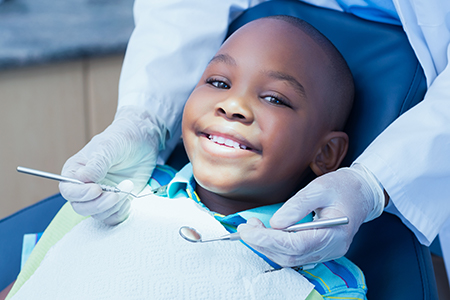At Mercer Island Dental Associates, the health and development of your child's smile are a primary focus. Our approach centers on prevention, education, and providing age-appropriate care so children build confident, healthy habits that last into adulthood. We combine modern diagnostic tools with a gentle, kid-friendly approach so visits are productive and positive for both children and caregivers.

Early dental experiences set the tone for a child's relationship with oral health. Beginning routine care in infancy or toddlerhood helps normalize appointments and gives parents practical guidance on brushing, fluoride use, and developmental milestones. When families learn what to expect at each stage, they can more confidently support their child’s routine and respond to problems before they escalate.
Our pediatric-focused care emphasizes prevention: routine exams, cleanings when appropriate, and tailored guidance about diet and oral hygiene. These visits are also a chance to monitor growth and development, ensure proper eruption of teeth, and discuss concerns such as thumb-sucking or pacifier use. A steady program of prevention reduces the likelihood of cavities and the need for more invasive treatment later.
A careful checkup uncovers early signs of decay, bite discrepancies, and habits that may affect future alignment. With digital X-rays used only as needed, we assess the development of permanent teeth and evaluate jaw growth. Early detection allows for simpler interventions, more predictable outcomes, and a clearer plan for any future orthodontic care.

Regular checkups are the backbone of pediatric oral health. During these visits, clinicians review medical and dental histories, conduct a hands-on exam of the teeth, gums, and soft tissues, and screen for conditions that could affect oral or overall health. When appropriate, a professional dental cleaning removes plaque and polishes teeth, making home care more effective between appointments.
Dental imaging—selected carefully and with a child’s comfort in mind—helps reveal areas not visible during a visual exam. These diagnostics are especially useful when assessing for cavities in the grooves of back teeth or monitoring the position of erupting permanent teeth. Our goal is to use the least invasive tools necessary to form a clear diagnostic picture.
We also focus on education during visits: demonstrating brushing and flossing techniques, suggesting toothbrush and toothpaste choices by age, and giving families practical tips to turn hygiene into a manageable routine. Parents leave with a clear understanding of next steps, whether that’s preventive fluoride, sealants, or simply continued observation.
Begin dental visits early to help your child become comfortable with care
Keep infant and toddler teeth clean with a soft cloth or an age-appropriate brush
Avoid putting babies to bed with milk or juice to reduce the risk of decay
Schedule routine checkups and cleanings so issues can be addressed promptly
Model good oral habits and make brushing and flossing a shared family task
Choose tooth-friendly snacks and encourage water instead of sugary drinks
Help children transition away from pacifiers and thumbs gradually and supportively
Use a properly fitted mouthguard for organized sports and high-risk activities

Healthy baby teeth are important for chewing, speech development, and holding space for adult teeth. The first dental visit—often recommended around a child's first birthday—gives parents a chance to ask questions about teething, pacifier concerns, and safe oral care practices. Early guidance helps families navigate common challenges without unnecessary worry.
Teething can be uncomfortable but manageable with safe, simple remedies like chilled teething rings or gentle gum massage. We explain safe practices for easing discomfort and highlight signs that warrant a call to the office. When new teeth arrive, we advise on appropriate toothpaste quantities and when children should begin practicing brushing on their own under supervision.
Because baby teeth serve as placeholders for permanent teeth, preventing early decay matters. Parents learn how to spot early warning signs, how diet affects tooth health, and strategies to reduce frequent sugar exposure. With timely care, many problems can be prevented or minimized before a more involved treatment is necessary.
As children grow, dental needs change. School-age kids often benefit from preventive measures such as sealants on the chewing surfaces of permanent molars and periodic topical fluoride to strengthen enamel. We review habits and diet, provide guidance about oral hygiene tools for older children, and discuss how to maintain a healthy smile even with busy schedules.
Monitoring facial growth and tooth alignment is a key part of care for older children and adolescents. Early orthodontic screening can identify bite issues or jaw discrepancies when they are easier to address. If corrective care is recommended, we coordinate with orthodontic specialists so treatment timing and goals align with the child’s overall development.
Sports and activities introduce additional considerations. A custom-fitted mouthguard protects teeth and soft tissues and can prevent more serious injuries. We guide families on the right protective gear for different sports and help ensure young athletes understand the importance of oral safety.
Accidents, toothaches, and sudden dental problems are stressful for children and caregivers alike. When injuries or acute pain occur, prompt assessment can preserve teeth and prevent complications. We provide clear instructions on what to do immediately after a dental injury and prioritize urgent cases to minimize discomfort and risk.
For children who experience anxiety, have special healthcare needs, or require extensive treatment, we discuss behavior guidance and sedation options when appropriate. Our focus is on creating a safe, compassionate plan that respects each child’s needs and reduces fear while delivering effective care.
Managing complicated situations also involves collaborating with pediatricians, orthodontists, and other specialists as needed. Coordinated care ensures that dental treatment supports overall health and fits into a child’s broader medical and developmental context.
Successful pediatric dental care is a partnership between clinicians, parents, and children. We aim to empower families with practical knowledge—what to watch for, how to prevent common problems, and when to seek care. Clear communication and a collaborative approach make appointments more productive and help children feel respected and secure.
Education is central to our work: we provide age-appropriate instruction, model proper techniques, and offer realistic strategies for busy households. Small, consistent habits at home add up to meaningful improvements in oral health over time, reducing the need for restorative care and supporting a confident smile.
If you’d like to learn more about pediatric dental care or discuss your child’s specific needs, contact us for additional information. Our team is available to answer questions and help you make informed choices for your child’s oral health.
A pedodontist is a dentist who has received advanced specialty training in meeting the dental needs of children from infancy to adolescence. Pedodontists, also referred to as "pediatric dentists," study child psychology, behavior management, caring for children with special needs, methods of handling oral/facial trauma, and various techniques for providing anesthesia and sedation. Pedodontists also understand the complexities of facial growth and development and have the clinical skills required to meet the dental needs of all children at every stage of development. Most of all, pedodontists are passionate about what they do and enjoy working with children. They strive to make every dental experience a positive one as they help children establish a strong foundation for good oral health.
Even before your child is born, their first set of teeth is already forming. In fact, by one year of age, some of your baby's front teeth will have already come into place. While the arrival of your baby's first teeth is only one of many developmental milestones, it represents an excellent time to begin a program of oral care. According to recommendations from the American Dental Association, babies should see the dentist around the time of their first birthdays.
Your baby's first teeth typically begin to appear in the 6 to 12-month range. While this is an extraordinary milestone, you need to be aware that your baby may find the experience a little bit uncomfortable. Teething can make babies feel irritable. They may be fussy, have trouble sleeping, not want to eat, and drool quite a bit.
Although you are powerless to speed up the process of teething, there are a few things that you can do to soothe your baby as the new teeth are erupting into place. Common approaches to helping your baby feel more comfortable while getting new teeth, include teething rings or a cold spoon or moist gauze rubbed over their gums.
Even for these few new teeth, it's absolutely essential to establish an effective regimen of oral care. For information on when your baby's first set of teeth will erupt into place, consult this timeline from the American Dental Association: Eruption Charts
Some children persist in sucking their thumbs or fingers beyond their preschool years. For these children, the activity continues to be a source of comfort, relaxation, and security. It may even help them fall asleep at night. However, it's essential to be aware that in the long-term, a finger sucking habit is not healthy.
If your child's thumb or finger sucking habit is still present when the permanent teeth begin to come in, your child is at a higher risk of developing a bad bite. By the age of five or six years, you need to constructively and gently help your child stop the habit.
It's also a good idea to have a comprehensive evaluation at this time. Your pedodontist can assess if there are any habit related alterations to the alignment of your child's teeth or jaws, or if it is affecting their speech or swallowing patterns. They can also discuss habit control strategies with you, as well as follow your child's bite and facial development as they grow. If interceptive appliances or corrective orthodontic care are recommended, the timetable and best options in care will be explained in complete detail.
We recommend scheduling a child's first dental visit by their first birthday or within six months after the first tooth appears. Early visits help normalize the dental environment and give parents practical guidance on cleaning, fluoride use, and preventing early decay. Establishing care early also allows the team to monitor development and answer questions about feeding, pacifiers, and teething.
At that initial appointment the emphasis is on comfort, education, and building a positive relationship with the dental team. The visit is usually short and noninvasive, focusing on a gentle exam and helpful tips parents can use at home. If concerns are identified, the staff will explain next steps and follow-up timing in clear, age-appropriate terms.
A pediatric dental exam includes a review of the child's health history, a hands-on evaluation of the teeth and gums, and screening for developmental issues that can affect oral health. Clinicians check for early signs of decay, inspect bite relationships, and observe how permanent teeth are erupting. When needed, small, focused digital X-rays are used selectively to clarify areas not visible during the visual exam.
During the visit the team also demonstrates brushing and flossing techniques and discusses age-appropriate toothpaste and tools. Parents receive guidance on diet, pacifier use, and habits that influence dental development. The goal is to create a clear, individualized plan that supports prevention and timely treatment when necessary.
Reducing cavity risk begins with consistent home care: brushing twice daily with an age-appropriate fluoride toothpaste, flossing once teeth contact, and limiting frequent exposure to sugary drinks and snacks. Parents can model brushing and make oral hygiene a family routine to help children adopt positive habits. Offering water between meals and choosing tooth-friendly snacks also limits the acid attacks that lead to decay.
Regular professional checkups and cleanings complement home care by removing plaque buildup and identifying early problems. The dental team can recommend targeted preventive measures, such as topical fluoride or sealants when appropriate, to strengthen enamel and protect vulnerable chewing surfaces. Clear communication between families and clinicians makes it easier to keep prevention consistent and effective.
Yes—when applied appropriately, topical fluoride treatments and dental sealants are safe and effective tools for preventing tooth decay in children. Fluoride helps strengthen enamel and reduce the risk of cavities, while sealants create a protective barrier over deep grooves on molars where decay often starts. Both interventions are conservative, painless, and commonly recommended as part of a preventive plan.
The dental team considers a child's age, risk factors, and medical history before recommending these measures and explains how they work. Sealants are typically placed on newly erupted permanent molars, and fluoride is used at intervals suited to the child's needs. Families are informed about the benefits and any aftercare so they can make confident decisions.
Most children benefit from dental exams and cleanings every six months, but the frequency can vary based on individual risk factors and clinical findings. Children with a history of rapid decay or special healthcare needs may need more frequent monitoring, while other children with excellent home care and low risk might follow a different schedule. The dentist will recommend a personalized interval that balances prevention with the child's comfort and availability.
Regular visits allow the team to track growth and tooth eruption, apply preventive treatments as needed, and address emerging concerns early. Sticking to the recommended schedule helps avoid more complex care later and supports steady progress toward long-term oral health. Families receive clear reminders and guidance to keep appointments consistent.
Dental X-rays are a valuable diagnostic tool and are used selectively for children when the benefits outweigh the minimal risks. Modern digital radiography exposes patients to very low levels of radiation, and the practice follows industry guidelines to limit exposure, using shielding and the least number of images necessary. X-rays help detect hidden decay, evaluate eruption patterns, and monitor jaw development when a visual exam is not sufficient.
The dentist tailors imaging to the child's age, clinical signs, and dental history, and will explain the reason for any recommended radiographs. Parents are encouraged to ask about safety measures and the specific information each image will provide. When used judiciously, radiographs contribute to more accurate diagnosis and less invasive treatment over time.
The team prioritizes a compassionate, child-centered approach that reduces fear and builds trust through clear explanations and gradual exposure. Techniques such as tell-show-do, positive reinforcement, and distraction are commonly used to make procedures more manageable and to empower children. For children with heightened anxiety or special needs, the practice discusses individualized behavior guidance and may offer calm, safe options to complete necessary care.
When more extensive treatment is required, the dentist outlines appropriate options and explains risks and benefits in plain language for caregivers. Sedation may be considered in specific cases, but only after a careful medical review and with proper monitoring to ensure safety. The emphasis is always on comfort, respect, and helping children feel confident about future visits.
For dental emergencies such as severe pain, knocked-out teeth, or broken restorations, prompt assessment is important to reduce complications and increase the chances of saving a tooth. Caregivers should contact the office right away and follow any immediate instructions provided, such as rinsing the mouth gently or placing a knocked-out tooth back in its socket if appropriate. The dental team will prioritize urgent cases and advise when to come in for same-day care.
While waiting for professional care, avoid giving aspirin directly in the mouth and keep any avulsed tooth moist in milk or a tooth preservation kit if available. For soft‑tissue injuries, apply gentle pressure to control bleeding and seek evaluation to rule out more serious issues. Clear guidance from the office helps families respond effectively and reduces stress during these events.
An orthodontic screening is typically recommended by age 7 to assess jaw growth and the eruption pattern of permanent teeth, since many bite issues are easier to address when detected early. Early evaluation does not always mean immediate treatment, but it can identify developing problems that benefit from monitoring or phased intervention. The pediatric dentist will discuss growth patterns, potential timing for orthodontic referrals, and whether coordinated care with a specialist is advisable.
Early collaboration between the dental team and orthodontists helps create predictable, efficient treatment plans if correction is needed. When braces or other appliances become necessary, timing is chosen to align with dental development and the child's overall health. Families receive straightforward explanations so they understand goals, expectations, and how orthodontic care fits into long-term oral health.
Infant oral care begins before teeth erupt by gently wiping gums with a clean, damp cloth after feedings to remove bacteria and sugars. When teeth appear, switch to a soft, age-appropriate toothbrush and a smear of fluoride toothpaste for children under three, increasing to a pea-sized amount as they get older and can spit. Routine care prevents early decay and establishes a foundation for healthy brushing habits.
Teething discomfort can often be relieved with chilled (not frozen) teething rings, gentle gum massage, and comfort from caregivers. The dental team provides guidance on safe remedies and advises when symptoms warrant an evaluation, such as prolonged fever or signs of infection. If you prefer, the office of Mercer Island Dental Associates can answer specific questions about teething, feeding practices, and early prevention strategies to keep your child's mouth healthy.
